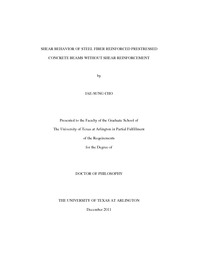
ATTENTION: The works hosted here are being migrated to a new repository that will consolidate resources, improve discoverability, and better show UTA's research impact on the global community. We will update authors as the migration progresses. Please see MavMatrix for more information.
Show simple item record
| dc.contributor.author | Cho, Jae-Sung | en_US |
| dc.date.accessioned | 2012-04-11T20:55:41Z | |
| dc.date.available | 2012-04-11T20:55:41Z | |
| dc.date.issued | 2012-04-11 | |
| dc.date.submitted | January 2011 | en_US |
| dc.identifier.other | DISS-11437 | en_US |
| dc.identifier.uri | http://hdl.handle.net/10106/9556 | |
| dc.description.abstract | The ACI 318-08 building code allows to use the steel fiber reinforcement as alternative shear reinforcement with satisfying certain criteria when a beam is required minimum shear reinforcement. However, this provision applies to a nonprestressed and prestressed concrete beam such that it could be conservative since the shear strength of prestressed concrete beam is generally enhanced due to the prestressing force. This is due partially to the fact that the provision has been accepted based on researches, mostly conducted in nonprestressed concrete beam. Most of experiments conducted for prestressed concrete beam in small scale tests, with a height of specimens were less than 10 in. A larger scale of experiment is required due to concerns of size effect. In addition, in order to evaluate the qualification of a Steel Fiber Reinforced Concrete (SFRC) mixture used for structural applications, such as increasing shear resistance, a material evaluation method is essential. Currently ASTM or ACI Committee 544 (Fiber-Reinforced Concrete) does not recommend any standardized test method for evaluating shear performance of a particular SFRC material. This study addresses the research gaps described above by testing large-scale Steel Fiber Reinforced Prestressed Concrete (SFRPC) beams as well as developing a simple laboratory test techniques. A total 13 simply-supported beams for large-scale test with a shear span to effective depth ratio of 3.0 and a height of 24 in. were subjected to monotonically-increased, concentrated load. The test parameters were mainly included compressive strength, volume fraction of steel fibers, compressive reinforcement ratio. The results of large-scale test showed that the use of hooked steel fibers in a volume fraction greater than or equal to 0.50% volume fraction of steel fibers (67 lb per cubic yard), which is less than requirement by ACI 318-08 (0.75%, 100 lb per cubic yard), led to substantial enhancement of shear behaviors including the first cracking, the ultimate, and ductility. High compressive strength of SFRC, greater than 9000 psi, which is higher than ACI 318-08 requirement (less than 6000 psi) could be used as well. However, there was no significant effect from compressive reinforcement ratio. A simply shear test method for SFRC was proposed in this study. The test apparatus is almost exactly the same as the conventional ASTM bending test with only minor modification, in addition, it could simulate a pure shear stress by adjusting loading and support positions. By introducing a proper reinforcement for bending stress, it was possible to evaluate shear performance of SFRC with clear and uncomplicated shear stress field in the critical section. | en_US |
| dc.description.sponsorship | Chao, Shih-Ho | en_US |
| dc.language.iso | en | en_US |
| dc.publisher | Civil & Environmental Engineering | en_US |
| dc.title | Shear Behavior Of Steel Fiber Reinforced Prestressed Concrete Beams Without Shear Reinforcement | en_US |
| dc.type | Ph.D. | en_US |
| dc.contributor.committeeChair | Chao, Shih-Ho | en_US |
| dc.degree.department | Civil & Environmental Engineering | en_US |
| dc.degree.discipline | Civil & Environmental Engineering | en_US |
| dc.degree.grantor | University of Texas at Arlington | en_US |
| dc.degree.level | doctoral | en_US |
| dc.degree.name | Ph.D. | en_US |
Files in this item
- Name:
- Cho_uta_2502D_11437.pdf
- Size:
- 33.99Mb
- Format:
- PDF
This item appears in the following Collection(s)
Show simple item record


